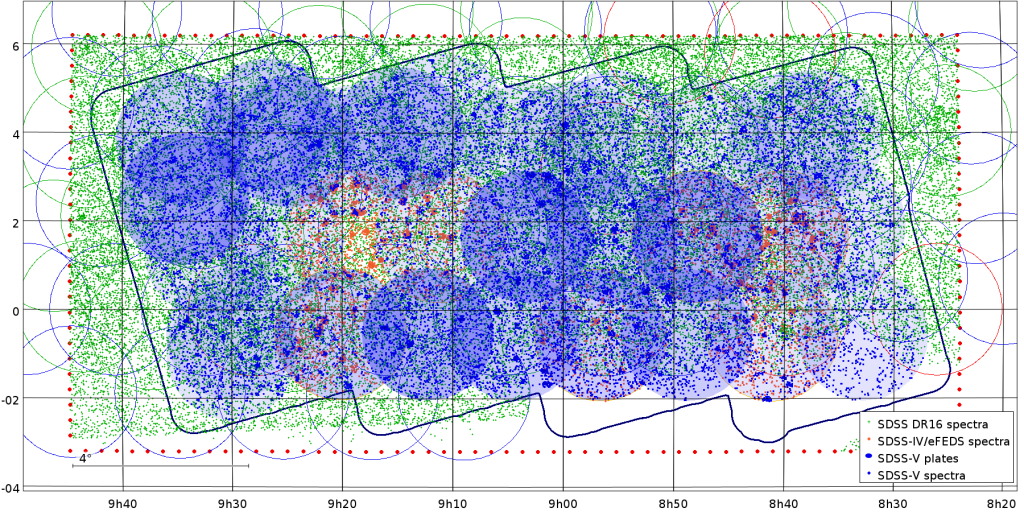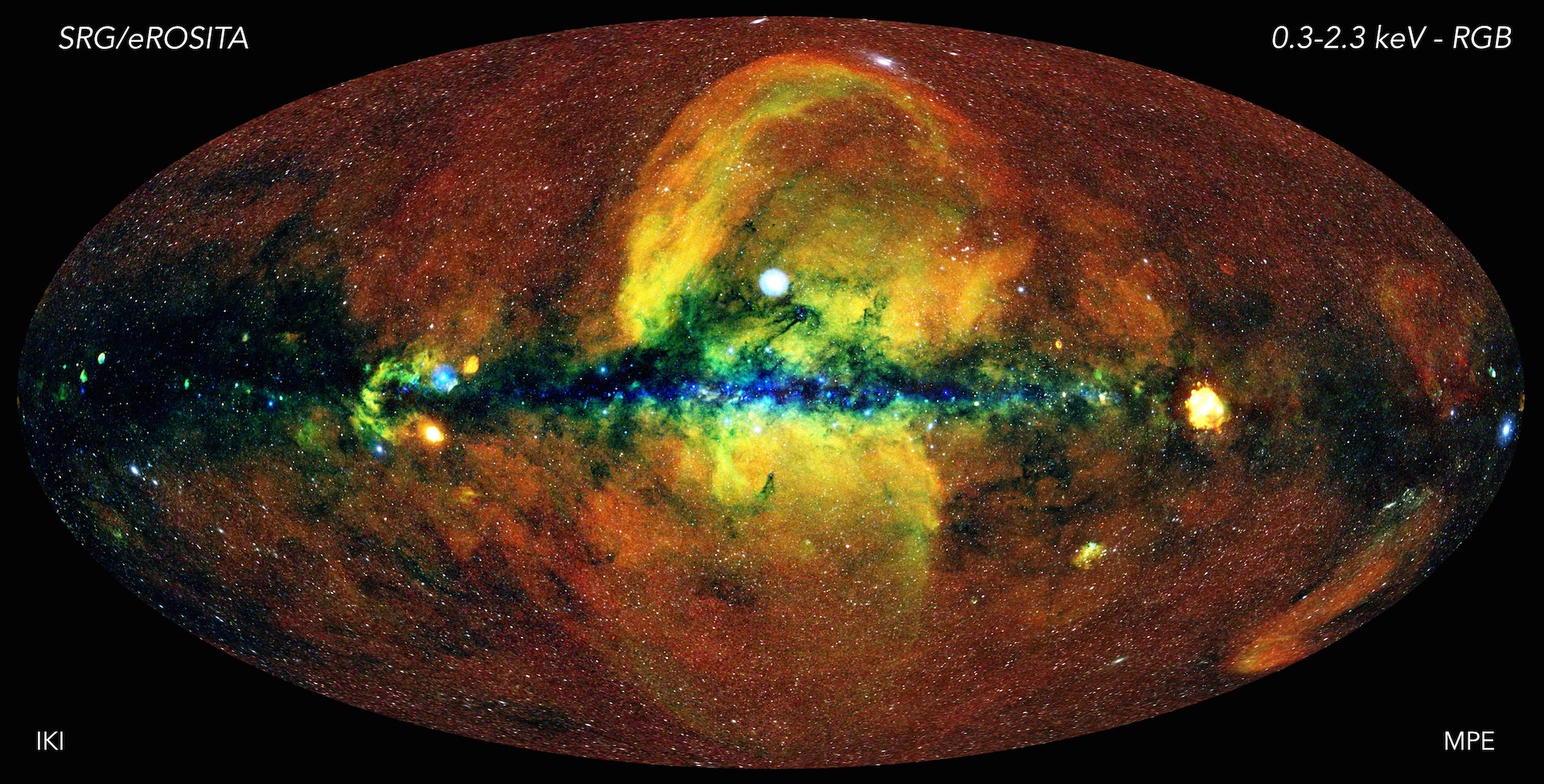Black Hole Mapper (BHM) emphasizes the study of quasars/AGN, as among Universe’s most luminous objects, powered by accretion onto supermassive black holes (SMBHs), and co-evolving via feedback with the host galaxies in which they reside. BHM exploits – with order(s) of magnitude advances – two hallmark characteristics of quasars: their marked variability on a range of timescales, and prodigious luminosity extending to X-rays. Major components include:
- Repeat time-domain optical (BOSS) spectra of ~104.5 known (SDSS) quasars over a broad range of timespans from days to decades, sampling changes on light-travel, dynamical, thermal, etc. timescales, in order to: measure BH masses; study broad line region (BLR) dynamics; capture and discover events, such as those in changing look quasars; and understand the astrophysics of quasar accretion and outflows. Such time-domain approaches probe spatially unresolved size scales.
- Optical (BOSS) follow-up spectroscopy of ~105.5 eROSITA – as well as ~104.5 Chandra – X-ray source counterparts, with BHM spectra providing counterpart identifications and redshifts, to study the demographics, evolution, and astrophysics of X-ray sources. These counterparts are mainly quasars/AGN , but also include X-ray emitting galaxy clusters and stars. The bulk of these will be derived from the first 1.5 years of eROSITA-DE repeat scans, though in DR18 we highlight BOSS spectroscopy of ~104 counterparts in the eROSITA eFEDS mini-survey region.

BHM Science Programs
The BHM Science Programs page provide further details about the science goals and target selection algorithms for: AQMES (All-Quasar Multi-Epoch Spectroscopy) and Reverberation Mapping which are the BHM core repeat time-domain science programs; SPIDERS (SPectroscopic IDentfication of ERosita Sources) which is the core BHM program of eROSITA X-ray source counterpart spectroscopic follow-up and includes eFEDS (eROSITA Full Equatorial Depth Survey); CSC (Chandra Source Catalog) X-ray counterpart follow-up; and other related Ancillary science programs. Additional BHM Science Background information may be found below.
BHM Instrumentation and Observations
SDSS-V operates dual hemisphere and BHM primarily makes use of the fiber-fed BOSS optical spectrographs, with the FPS robotically positioned fiber system from both the Sloan Foundation 2.5m Telescope at Apache Point Observatory (APO) and the Irénée du Pont Telescope at Las Campanas Observatory (LCO). BOSS optical data are reduced with the BOSS pipeline. See the BHM Getting Started page and links therefrom for some further hints on beginning to work with BHM data (and the BHM Caveats page for some things to keep in mind).
BHM Infrastructure and Science Organization
BHM Program Head: Scott Anderson (Univ. of Wash.),
BHM Survey Scientists: Andrea Merloni (MPE) and Yue Shen (Univ. of Illinois)
BOSS pipeline: Sean Morrison (Univ. of Illinois) and Hector Ibarra-Medel (Univ. of Atacama)
BHM targeting and survey strategy: Tom Dwelly (MPE) and Jon Trump (Univ. of Conn).
Commissioning scientist: Joe Burchett (NMSU)
Current BHM Scientific Working Groups (and their co-chairs)
Quasar Physics: Mike Eracleous (Penn State Univ.) and Benny Trakhtenbrot (Tel Aviv Univ.)
Reverberation Mapping: Kate Grier (Univ. of Wisc.) and Keith Horne (Univ. of St Andrews)
AGN Demographics: Johannes Buchner (MPE)
X-ray Clusters of Galaxies: Johan Comparat (MPE)
BHM Science Background
Quasars are among the most luminous objects in the Universe, powered by accretion onto supermassive black holes (SMBHs), and marking and tracing the growth of SMBHs across cosmic distance and time. The tight correlation between the mass of the central SMBH and the properties of its host galaxy demonstrate a clear connection between the formation of the galaxy’s stellar component and the growth of its central SMBH.
In order to study the astrophysics and cosmic history of accreting SMBHs, several parameters are especially important, including BH mass, bolometric luminosity, and radiative efficiency. Radiative efficiency (the fractional energy release per accreted mass) can be obtained from models of the continuum spectral energy distribution (SED) and variability, and most reliably where the BH mass is well determined. In turn, observational tests of BH theory and cosmic growth history seek accurate measures of BH mass, multi-wavelength SEDs (with redshifts to set luminosity), and variability characteristics. The Black Hole Mapper (BHM) in SDSS-V will provide such measures accurately for unprecedentedly large samples, exploiting two hallmark characteristics of quasars, as accreting SMBHs: their marked spectral variability across a range of timescales, and their prodigious luminosity extending even up to X-rays.
Most quasars show variability (typically ~10%) that encodes information about the structure and dynamics of emitting regions, probing the underlying physics of accretion and feedback processes in active SMBHs. Most quasars also show energetic X-ray emission, at once allowing us to peer deeply into central engines while also providing an (obscuration-)unbiased census of actively accreting SMBHs and their cosmic evolution. It is in the innermost parts of the accretion flow (hot X-ray corona, accretion disk, BLR, etc.), all within the gravitational sphere of influence of the SMBH, where the most dramatic emission and dynamic processes (e.g., X-radiation, winds and outflows, photoionization, dynamical evolution, etc.) associated with accretion are taking place. X-rays and optical variability allow us to peer into those small scales, which are sub-parsec for a typical 108 solar mass BH: X-rays are less affected by surrounding structures, and optical/UV variability arising in unsteady accretion flows and dynamical evolution of the feeding material can be observed over a broad range of timescales from days to decades providing temporal resolution for regions too small to be spatially resolved directly.
The past few decades have witnessed the success of using time-domain variability to constrain basic models of quasars, and BHM extends these adding extensive wide-area, multi-epoch optical spectroscopy to the era of time-domain imaging. In its Reverberation Mapping program, BHM will measure BH masses (the most fundamental of all BH parameters) for ~1000 quasars across a broad range of luminosity and redshift, dwarfing the historical RM sample of ~100 nearby and low-luminosity AGN. Via its AQMES (All-Quasar Multi-Epoch Spectroscopy) program, BHM will further characterize the spectral variability of more than ~20,000 additional quasars sampling light-travel, dynamical, and thermal timescales of days to decades, revealing broad emission line profile variations, SMBH binarity, outflow constraints, and rare quasars that shut off/on in just a few years (changing-look quasars), shedding new light on fundamental questions of SMBH accretion astrophysics.

In addition, despite the high X-ray luminosity of nearly all quasars and other AGN (active galactic nuclei) , we do not yet fully understand the physical origin of the tight coupling between the hot X-ray corona and the cold accretion disk. This is mostly due to the limited size of X-ray quasar/AGN samples compiled with past X-ray telescopes which have the necessary sensitivity (Chandra, XMM-Newton), but are limited by their relatively small fields of views (FOVs). However, the successful 2019 launch of eROSITA, with both its high sensitivity and large FOV, discovered as many new X-ray sources in its first year alone as were previously known, after more than 50 years of X-ray astronomy. Via its SPIDERS program, BHM is providing optical spectroscopic measurements (to about iAB<21.5), including identifications and redshifts, of ~300,000 eROSITA sources detected in the first 1.5 years of the all sky survey (to a 0.5-2 keV flux limit of ~2.5×10-14 erg/s/cm2). This eROSITA selected sample – as well as a smaller X-ray selected sample from the Chandra Source Catalog (CSC) – will be comprised mainly of AGN, both unobscured and obscured; but these samples will also contain X-ray emitting galaxy clusters, X-ray-bright stars (e.g., compact binaries and flaring late-type stars) in the Milky Way and nearby galaxies, extreme/rare objects, transients, and other peculiar variables found in the X-ray sky. Combining X-ray discovery and optical spectral characterization will provide a major leap forward in our description of the X-ray sky, and reveal the connections between large, statistical populations of X-ray sources and the cosmic structures in which they are embedded.

BHM Data
What’s new in DR18?
- New SDSS-V plate-mode BOSS optical spectroscopic data for (mostly) X-ray selected targets in the eROSITA ‘eFEDS’ field
- New eFEDS spectroscopic compilation Value Added Catalogue (VAC)
- New BHM Targeting catalogues for the SDSS-V/FPS era
Previous SDSS Data particularly relevant to BHM science
Please also see earlier SDSS data releases, including both DR16 and DR17, which e.g., include some BHM relevant science and data, from other earlier SDSS programs:
- eBOSS sub- or ancillary-programs on SDSS-IV SPIDERS , TDSS, and reverberation mapping (including optical follow of ROSAT X-ray sources, and time-domain repeat quasar spectroscopy).
- The DR16 Quasar Catalog which is an important underlying targeting catalog for some BHM repeat quasar spectroscopy, especially BHM/AQMES.
- SDSS-IV eFEDS plate data in DR17, which provides initial BOSS spectroscopy on 7 plates in the eFEDS region
